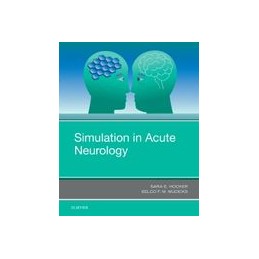- Reduced price

Order to parcel locker

easy pay


 Delivery policy
Delivery policy
Choose Paczkomat Inpost, Orlen Paczka, DHL, DPD or Poczta Polska. Click for more details
 Security policy
Security policy
Pay with a quick bank transfer, payment card or cash on delivery. Click for more details
 Return policy
Return policy
If you are a consumer, you can return the goods within 14 days. Click for more details
Simulation in Acute Neurology is a textbook on the execution of a simulation-based educational program in the management of acute neurologic emergencies. Simulation in Acute Neurology has practical value because it contains detailed descriptions of our simulation scenarios. The foundation of this book is our experience with neurosimulation?and it has been a very good one.
Part I provides an overview of the principles of simulation in medicine and examines the many unique opportunities simulation provides as an educational tool. Barriers to simulating neurologic emergencies are also discussed. Simulation allows a physician-in-training to be observed directly as he or she evaluates and manages acute neurologic disease.
Part II is the core of the book. Fifteen acute neurologic emergencies, including complex neuroethical quandaries, are presented in detail, step by step, decision by decision, error after error. Each chapter in this section starts with an explanation of the essence of the discussed neuroemergency (THE PROBLEM BEFORE US), followed by a description of the scenario itself (THE PRESENTING CLINICAL PROBLEM), how scenarios can be adjusted to different types of learners (ADAPTING THE SCENARIO), and ends with a discussion of topics for feedback, which are generally focused around errors and pitfalls (DEBRIEFING). To show the flow of scenarios, we created two additional main headings:: (THE IDEAL LEARNER) and (THE NOT-SO IDEAL LEARNER).
Data sheet
Part I. GENERAL PRINCIPLES
Chapter 1 Principles of Simulation
Chapter 2 Simulation of Acute Neurology
Chapter 3 Developing Scenarios
Part II. TEACHING SCENARIOS
Chapter 4 Simulating Traumatic Brain Injury
Chapter 5 Simulating Acute Carotid Artery Occlusion
Chapter 6 Simulating Basilar Artery Occlusion
Chapter 7 Simulating Aneurysmal Subarachnoid hemorrhage
Chapter 8 Simulating Delayed Ischemic Neurologic Deficits
Chapter 9 Simulating Cerebral Venous Sinus Thrombosis
Chapter 10 Simulating Coma of Unknown Cause
Chapter 11 Simulating Neuromuscular Respiratory Failure
Chapter 12 Simulating Status Epilepticus
Chapter 13 Simulating Encephalitis
Chapter 14 Simulating Acute Spinal Cord Compression
Chapter 15 Simulating Fulminant Bacterial Meningitis
Chapter 16 Simulating Posterior Reversible Encephalopathy Syndrome
Chapter 17 Simulating Brain Death
Chapter 18 Simulating Problematic Family Conferences
